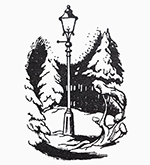
The Infinite & Final
"Nature has that in her which
compels
us to invent giants" (4).
C. S. Lewis's "On Stories"
Points for Reflection
C. S. Lewis's "On Stories" (1947)
- What does Lewis mean by a story which places story itself in the center of things?
- Today’s reader might be inclined to fault Lewis for admitting a fascination with the ethnically esoteric in his youth—with being enthralled by that element of strangeness and mystery which James Fenimore Cooper ties to indigenous Americans (1) and which H. Rider Haggard ties to a secretive African tribe. Whatever your reaction to someone’s being intrigued with the culturally strange—what post-structuralist Edward Said might class as a type of troubling orientalism—consider whether you have ever experienced this feeling yourself. If so, was it caused by an actual environment you temporarily inhabited, a fantasy world entered through the imagination, or both?
- Remember that a literary Romance contains extraordinary events happening to extraordinary characters--as opposed to what we find in Realism. (The Romance may not contain a heart-throbbing “romance” in it at all.). What has Lewis so enjoyed in the Romances he has read over the years?
- What does Lewis mean by the distinction between “kinds” and “degrees” of danger?
- What feeling generated by the presence of a fictional giant does Lewis think more important than mere fear of danger?
- Lewis contends that a sense of “eternal silences” has caused what two similar, if ideologically divergent, reactions?
- What kinds of things, ignored by the “narrow and desperately practical perspectives of real life” (5), does Lewis find often spotlighted in the arts?
- Does Lewis believe stories that draw us into another world prepare us better for real life?
- Can one, according to Lewis, enjoy a story thoroughly with only a single read through?
- In what ways does a literary romance resemble real life, to Lewis’s mind?

original illustration for
The Lion, the Witch, and the Wardrobe
Pauline Baynes
Dr. Paul
Marchbanks
pmarchba@calpoly.edu
![]()
